An overview - VAGRANT
About Me !



What is Vagrant?
- A tool for developers
- A VM management tool
- Automate the setup of your development environment
New starter
- Someone joins your project...
- They pick up their laptop...
- Then spend the next 1-2 days following instructions on setting up their environment, tools, etc.
Instead, lets do this.
New starter
- Someone joins your project...
- They pick up their laptop...
- Then spend the next 10 minutes running a script which sets their environment up for them.
Step by step
Prerequisites
- Virtualbox
- Vagrant
- Both Virtualbox and Vagrant have great, simple installation instructions.
Setting up the box
Getting set up
- Add a Vagrant box
- Create the VM
- Configure the VM
- Set up your project environment
Adding a box*
*What's a box? We'll cover that shortly.
Setting up Ubuntu Precise
- vagrant box add ubuntu-precise http://cloud-images.ubuntu.com/precise/current/precise-server-cloudimg-vagrant-i386-disk1.box
- vagrant init ubuntu-precise
- vagrant up
Adding the box
- vagrant box add ubuntu-precise http://cloud-images.ubuntu.com/precise/current/precise-server-cloudimg-vagrant-i386-disk1.box

Adding the box
- vagrant box add ubuntu-precise http://cloud-images.ubuntu.com/precise/current/precise-server-cloudimg-vagrant-i386-disk1.box

Adding the box
- vagrant box add ubuntu-precise http://cloud-images.ubuntu.com/precise/current/precise-server-cloudimg-vagrant-i386-disk1.box
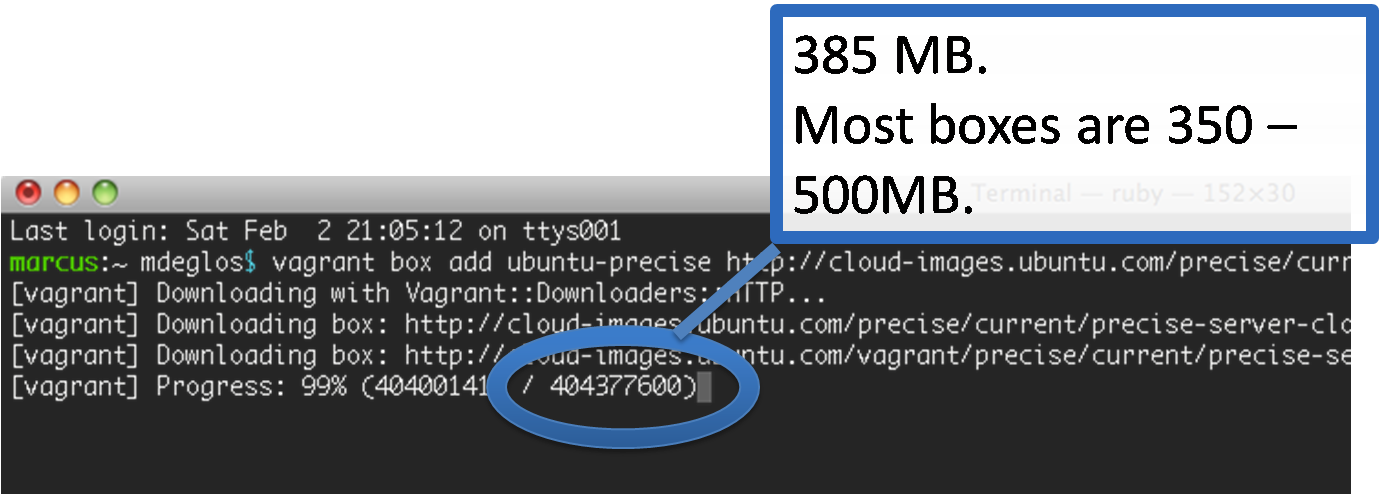
Adding the box
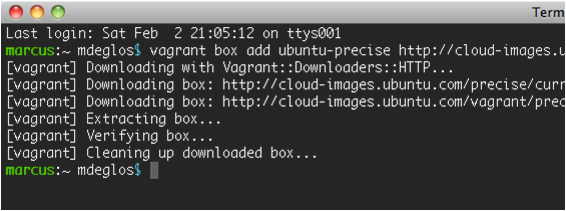
Getting set up
- Add a Vagrant box
- Create the VM
- Configure the VM
- Set up your project environment
Start with a working dir.
- mkdir -p ~/Development/awesome_project
- cd ~/Development/awesome_project

Initialise the Vagrant setup
- vagrant init ubuntu-precise

Launch the Vagrant VM
- vagrant up
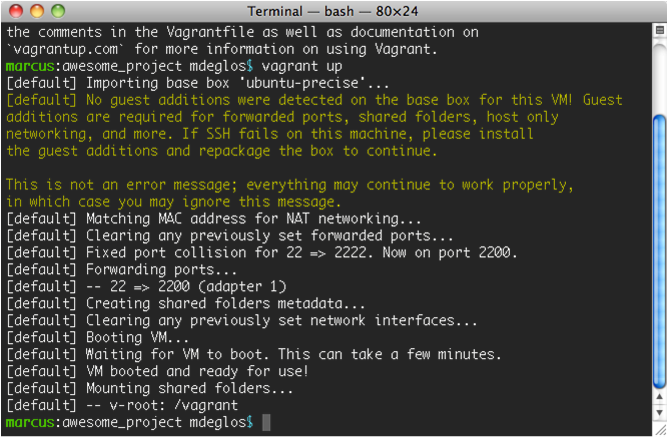
Launch the Vagrant VM
- vagrant up
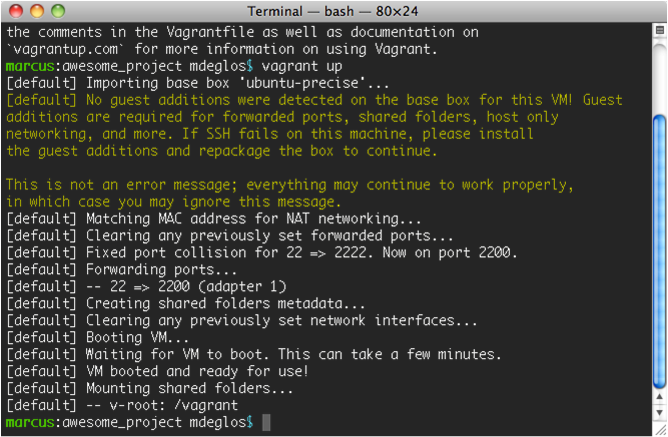
Getting set up
- Add a Vagrant box
- Create the VM
- Configure the VM
- Set up your project environment
SSH to the VM
- vagrant ssh
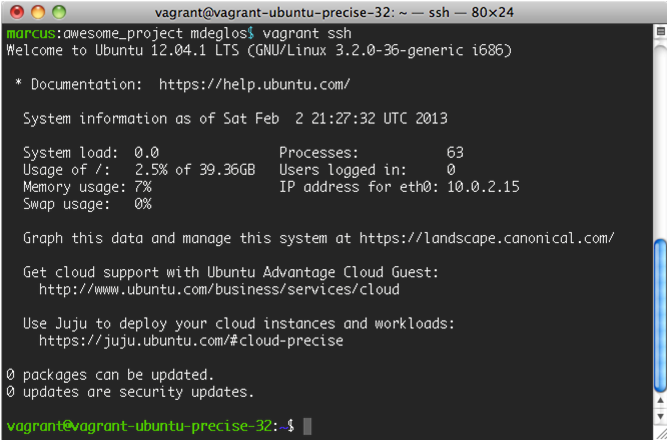
Install all the things !
- sudo apt-get install curl apache2 avahi-daemon avahi-discover avahi-utils gcc git-core libapache2-mod-dnssd make mysql-server samba subversion unzip vim php5 php-apc php5-cli php5-curl php5-dev php5-gd php5-memcache php5-memcached php5-mysqlnd php5-xdebug
- These aren't all essential, but make a good base for a good development environment.
Install all the things !
- sudo apt-get install curl apache2 avahi-daemon avahi-discover avahi-utils gcc git-core libapache2-mod-dnssd make mysql-server samba subversion unzip vim php5 php-apc php5-cli php5-curl php5-dev php5-gd php5-memcache php5-memcached php5-mysqlnd php5-xdebug
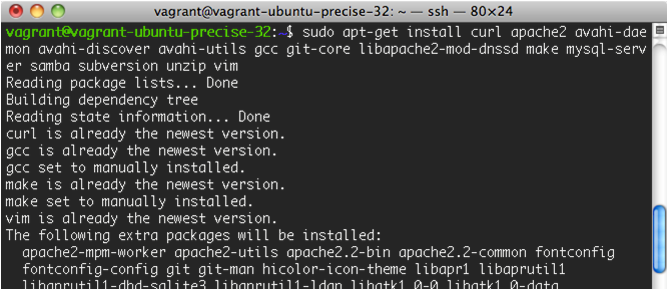
Getting set up
- Add a Vagrant box
- Create the VM
- Configure the VM
- Set up your project environment
Create a Drupal setup
- sudo mkdir /srv/awesome_project
- sudo chown vagrant:vagrant /srv/awesome_project
- cd /srv/awesome_project
- git clone git@github.com/example/awesome_project.git htdocs
- mkdir /srv/awesome_project/conf
- touch /srv/awesome_project/conf/httpd.conf
- sudo ln -s /srv/awesome_project/conf/httpd.conf /etc/apache2/sites-available/awesome_project.conf
- sudo ln -s ../sites-available/awesome_project.conf /etc/apache2/sites-enabled
Set up your environment
- mysql -e "GRANT ALL ON *.* TO 'vagrant'@'localhost' IDENTIFIED BY '' WITH GRANT OPTION"
- Add whichever setup instructions are appropriate for your environment
Manual setup is baad, mmkay?
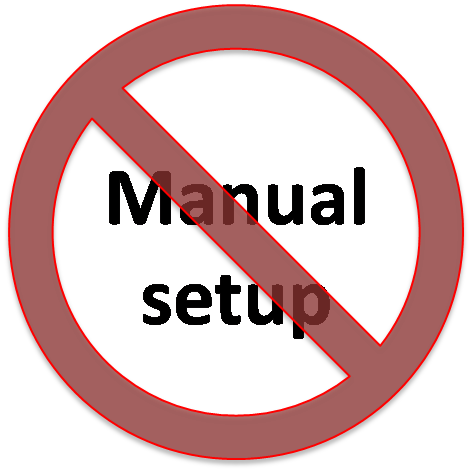
Streamlining the setup
Option 1 - A magick box.
Start with a customised box
- vagrant box add awesome_project http://boxes.example.com/supercool_drupal_project.box
Start with a customised box
- vagrant box add awesome_project http://boxes.example.com/supercool_drupal_project.box
A magick box.I'll explain later!
Follow the standard setup
- mkdir -p ~/Development/awesome_project
- cd ~/Development/awesome_project
- vagrant init awesome_project
- vagrant up
Connect to the box
- vagrant ssh
Verify what's in the box
- ls /srv/
- which drush
- mysql -e 'show databases;'
Verify what's in the box
- ls /srv/
- which drush
- mysql -e 'show databases;'
vagrant@vm-druprecise:~$ ls -l /srv/
total 4
drwxr-xr-x 3 root root 4096 Mar 10 18:28 foo.local
Verify what's in the box
- ls /srv/
- which drush
- mysql -e 'show databases;'
vagrant@vm-druprecise:~$ which drush
/usr/local/bin/drush
Verify what's in the box
- ls /srv/
- which drush
- mysql -e 'show databases;'
vagrant@vm-druprecise:~$ mysql -e 'show databases';
| Database | |
|---|---|
| 1. information_schema | 2. foo_local |
| 3. mysql | 4. performance_schema |
| 5. phpmyadmin | |
Recap of all those steps
- vagrant box add awesome_project http://boxes.example.com/supercool_drupal_project.box
- mkdir -p ~/Development/awesome_project
- cd ~/Development/awesome_project
- vagrant init awesome_project
- vagrant up

A stream-lined setup
Option 2 - A vagrant config.
Start with a build directory
- mkdir -p ~/Development/awesome_project
- cd ~/Development/awesome_project
Checkout a Vagrant config
- git clone git@github.com/Techito/vagrant_drupal_box.git.
Verify the checkout
- ls -l

Verify the checkout
- ls -l
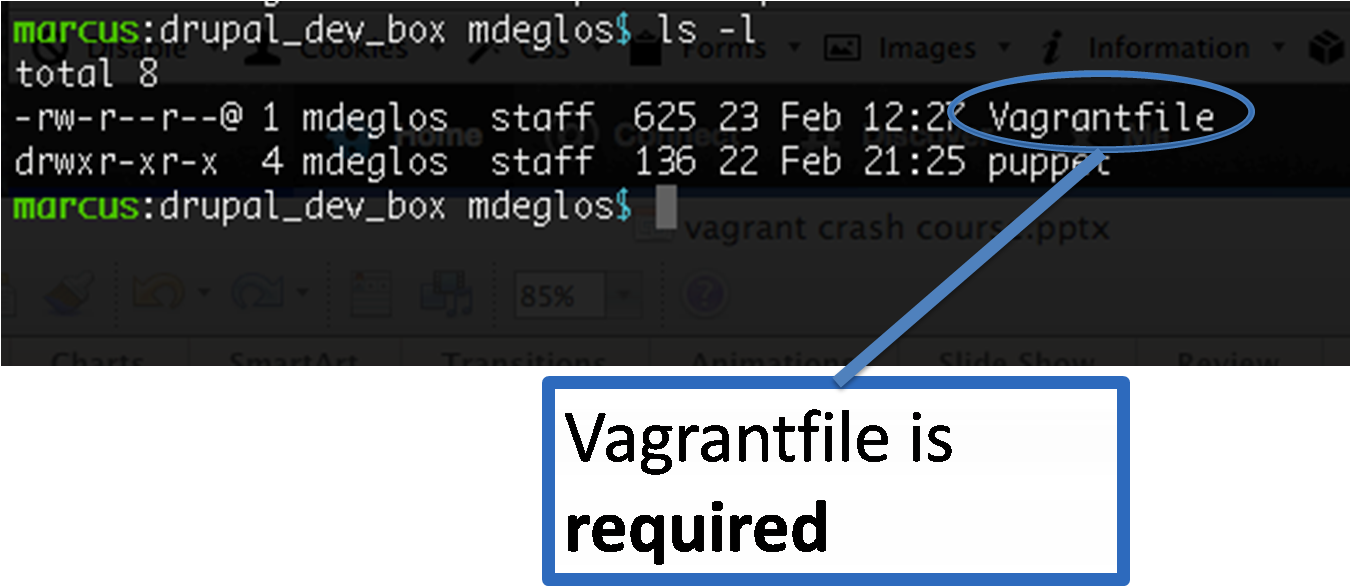
Verify the checkout
- ls -l
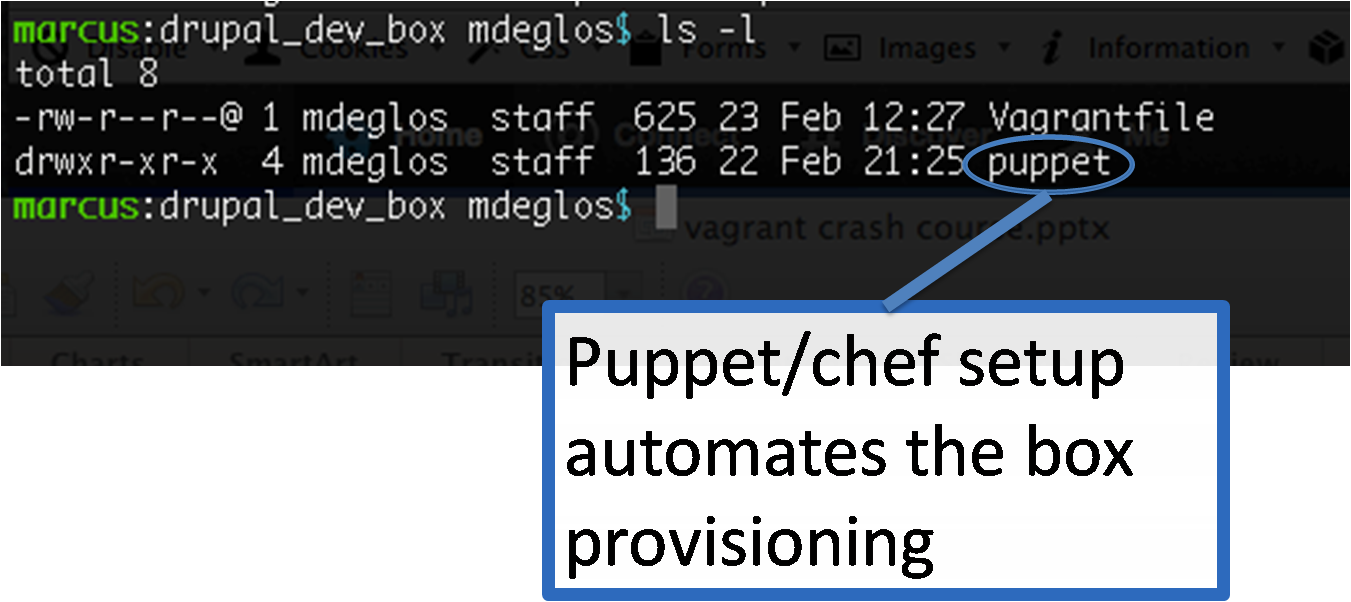
Get Vagrant going
- vagrant up
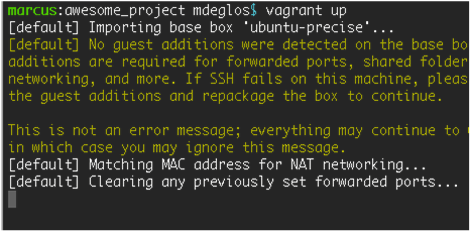
Connect to the box
- vagrant ssh
Verify what's in the box
- ls /srv/
- which drush
- mysql -e 'show databases;'
Verify what's in the box
- ls /srv/
- which drush
- mysql -e 'show databases;'
vagrant@vm-druprecise:~$ ls -l /srv/
total 4
drwxr-xr-x 3 root root 4096 Mar 10 18:28 foo.local
Verify what's in the box
- ls /srv/
- which drush
- mysql -e 'show databases;'
vagrant@vm-druprecise:~$ which drush /usr/local/bin/drush
Verify what's in the box
- ls /srv/
- which drush
- mysql -e 'show databases;'
vagrant@vm-druprecise:~$ mysql -e 'show databases';
| Database | |
|---|---|
| 1. information_schema | 2. foo_local |
| 3. mysql | 4. performance_schema |
| 5. phpmyadmin | |
Recap of all those steps
- mkdir -p ~/Development/awesome_project
- cd ~/Development/awesome_project
- git clone git@github.com/example/awesome_project.git .
- vagrant up

Automated provisioning
=
super-quick setup
Vagrant vocabulary
Vagrant Vocabulary
- Virtualbox
An application to run "Virtual machines" on your laptop/desktop. - Vagrant
An application that automates the setup of VMs. - Host
The laptop/desktop that runs Virtualbox + Vagrant. - Guest / Guest VM / Instance
The virtual machine running within the host.
Vagrant Vocabulary
- Mount
A way of sharing files between the host and guest (this is a simplification - search for "disk mount" for a more detailed explanation). - Provision / Provisioning
Setting up the VM, installing packages, configuring users, etc. - Box / Base box
A template for a Virtual Machine. - Vagrantfile
A set of instructions to Vagrant on how to build and configure a VM.
A "magick" pre-packaged box, or a vagrant config structure.
Two approaches
Standard practice
- Start with a base-box of choice.
– Ubuntu, CentOS, Debian...?
– 32 bit vs 64 bit
Standard practice
- Start with a base-box of choice.
- Add a Vagrantfile. – `vagrant init` will give you a template
– Ubuntu, CentOS, Debian...?
– 32 bit vs 64 bit
Standard practice
- Start with a base-box of choice.
- Add a Vagrantfile. – `vagrant init` will give you a template
- Configure the Vagrantfile. – Hostname, network adapters, config paths...
– Ubuntu, CentOS, Debian...?
– 32 bit vs 64 bit
Standard practice
- Start with a base-box of choice.
- Add a Vagrantfile. – `vagrant init` will give you a template
- Configure the Vagrantfile. – Hostname, network adapters, config paths...
– Ubuntu, CentOS, Debian...?
– 32 bit vs 64 bit
Great docs at http://vagrantup.com/
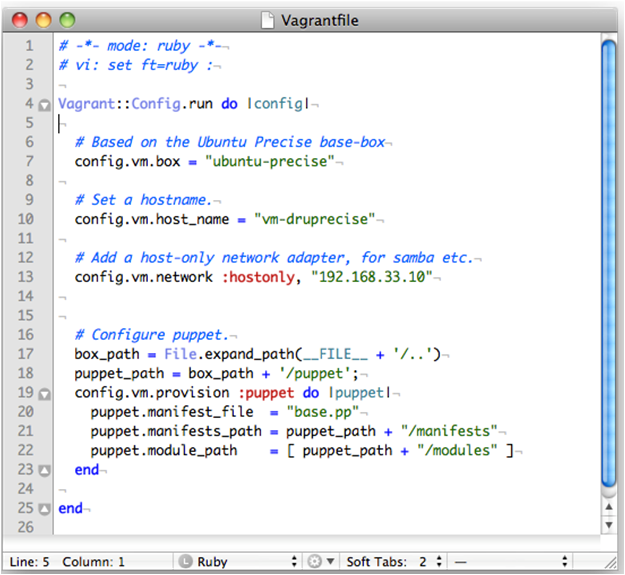
Standard practice
- Start with a base-box of choice.
- Add a Vagrantfile. – `vagrant init` will give you a template
- Configure the Vagrantfile. – Hostname, network adapters, config paths...
- Add puppet/chef manifests
– Ubuntu, CentOS, Debian...?
– 32 bit vs 64 bit
Standard practice
- Start with a base-box of choice.
- Add a Vagrantfile. – `vagrant init` will give you a template
- Configure the Vagrantfile. – Hostname, network adapters, config paths...
- Add puppet/chef manifests
– Ubuntu, CentOS, Debian...?
– 32 bit vs 64 bit
I'll talk briefly on puppet + chef shortly
What's in the "magick" box?
- vagrant box add awesome_project
http://boxes.example.com/supercool_drupal_project.box
A magick box.
What's in the "magick" box?
- I started with a standard Vagrant base-box(I used the ubuntu-precise package, supplied by Canonical).
- I tweaked the Vagrantfile, and added puppet config (in the same way as setting up a regular Vagrant VM).
- I used a special packaging script to package the base-box, with the Vagrantfile and the puppet manifests included.
What's in the "magick" box?
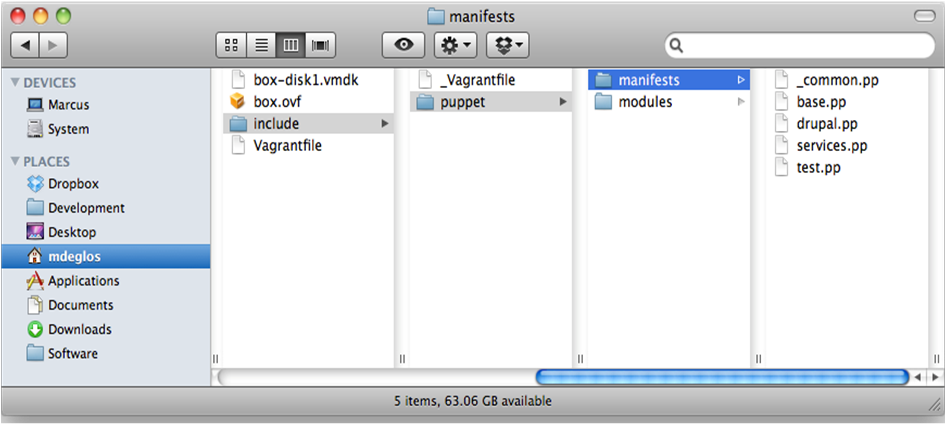
What's in the "magick" box?
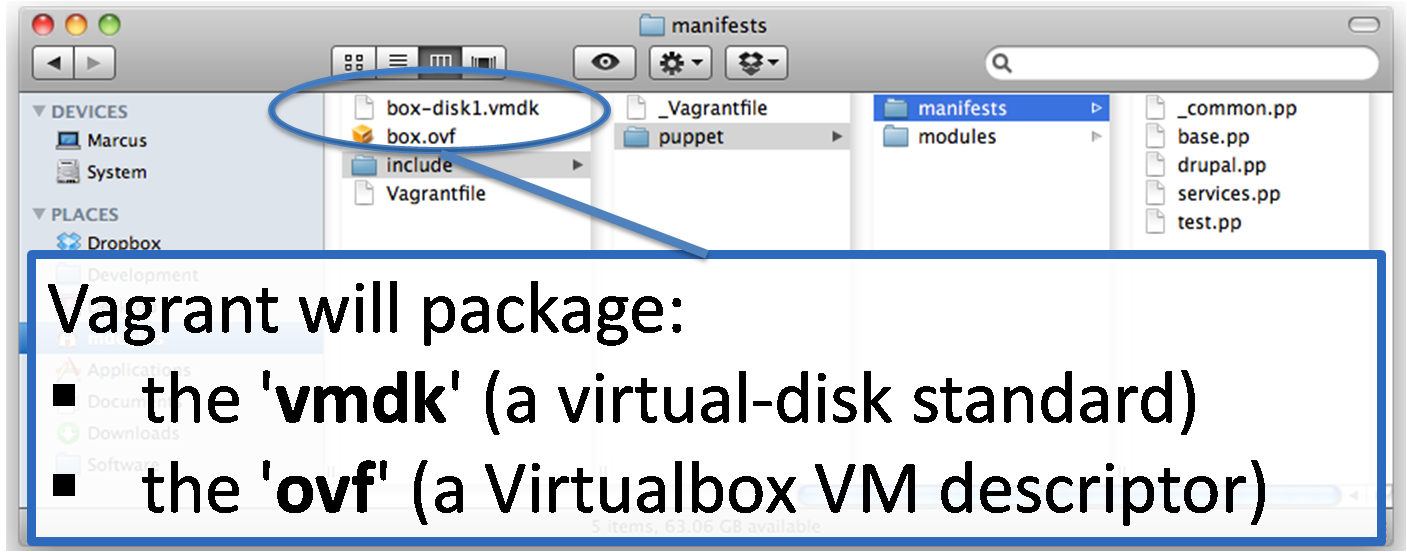
What's in the "magick" box?
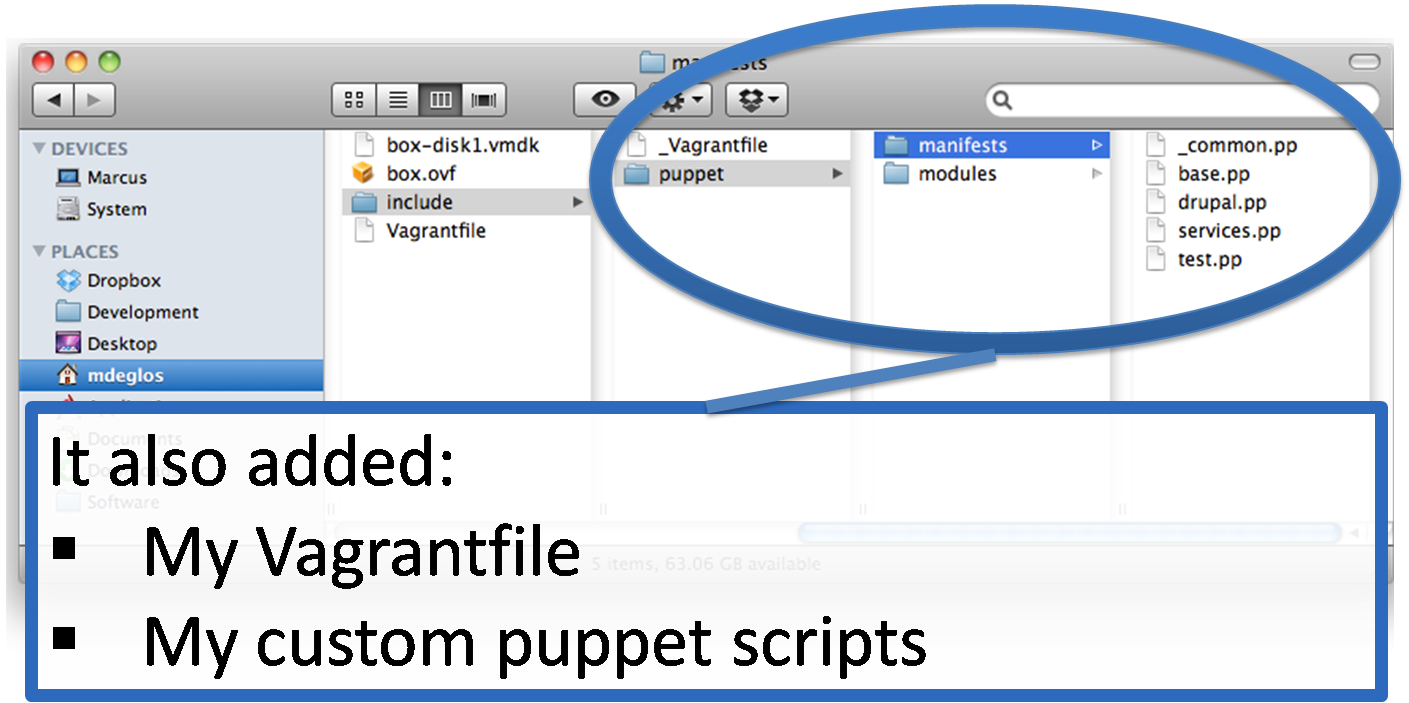
What's in the "magick" box?
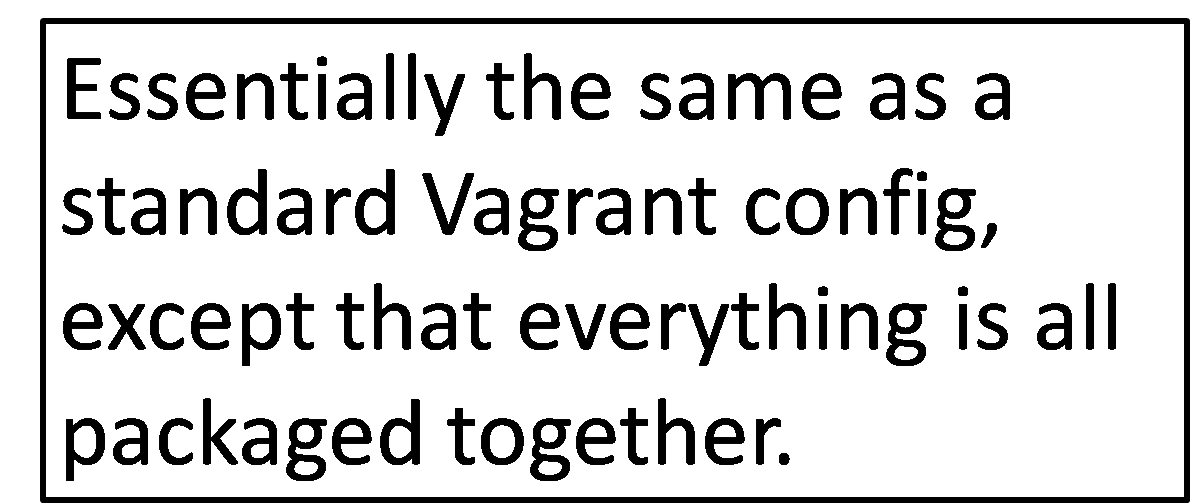
Magick box vs standard config
-
Magick
- Simpler for junior developers.
- Puppet/chef config tucked away out of sight.
- Base-box and config stored together in one place.
- Streamlined setup. Standard
- Standard practice.
- No surprises, everything visible.
- Easily updateable (and version-controllable).
- No special packaging required.
Magick box packaging
Packaging practices
-
☞ Puppet/chef only
- Smaller base-box.
- Requires internet access to build.
- Always fetches latest version of the packages.
- Larger base-box.
- Ready to go without needing internet access.
- Packages may become out-of-date.
☞ Complete packaging
Creating your own base box
Why create a base box?
- More flexibility than puppet/chef alone
- Trusted source
- Specific version of O/S (maybe you really want to run Slackware as your O/S of choice!)
How to create a base box
- Start by creating the VM in Virtualbox* as usual.
- Follow community standards where possible (sizing of VM, disk, RAM, etc).
- Add several Vagrant-specific tools (an SSH key, etc). Instructions on http://vagrantup.com/.
- OR: use Veewee to build it for you.
✽ Vagrant is becoming less Virtualbox-specific, so you may be able to use a different provider, such as VMWare.
Choosing a basebox
Choosing a base box
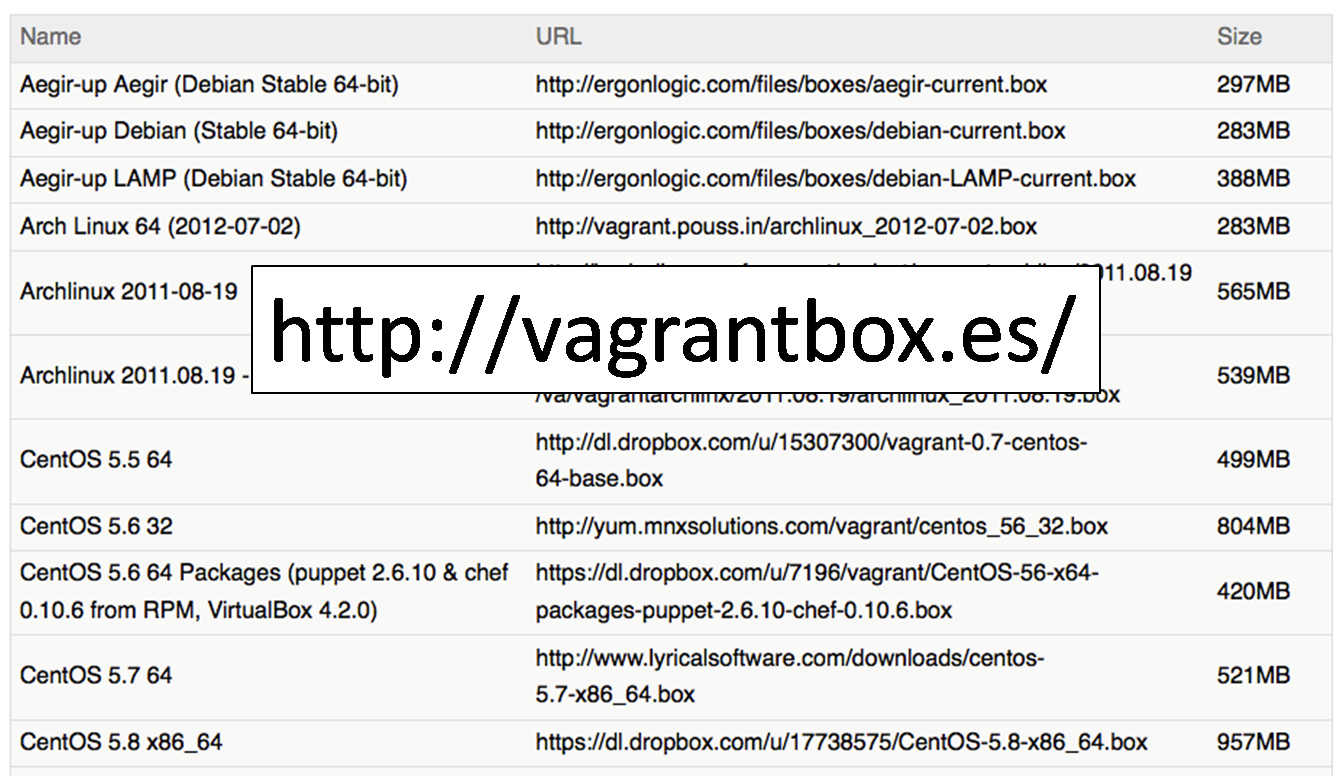
Puppet or chef?
Puppet or Chef?
- Puppet and Chef do the same thing – automated provisioning:
- Installing packages (apt-get install / yum install)
- Creating users + groups
- Managing config files
- Any provisioning task imaginable(but you might have to write the plugin)
- Both are Ruby applications.
- Both have an active open-source community.
Puppet or Chef?
- How do you choose?
– Is anyone in your team familiar with either of them?
– Do you use any modules/packages/vagrant setups which expect one or the other?
– Can you easily find support (either paid-for or free) in your community?
Puppet or chef resources
-
Puppet
- The Drupal.org testbots http://drupal.org/project/drupaltestbot-puppet
- Demo from this talk https://github.com/Techito/vagrant_drupal_box
- Project Oscar https://github.com/manarth/oscar Chef
- Megalodon https://github.com/msonnabaum/megalodon (native install, rather than VM).
- Drupal Vagrant project http://drupal.org/project/vagrant
Key resources
- Virtualbox
https://www.virtualbox.org/ - Vagrant
http://vagrantup.com/ - Base-box list
http://www.vagrantbox.es/ - Puppet resources
http://puppetlabs.com/ - Chef resources
http://www.opscode.com/chef/
Other resources
- Drush Vagrant
http://drupal.org/project/drush-vagrant - Veewee (to build base boxes)
https://github.com/jedi4ever/veewee - IRC: #vagrant
Beyond Vagrant & dev VMs
Beyond Vagrant & dev VMs
- Vagrant is expanding to cover other provisioning tools: – VMWare Fusion
- Puppet and Chef can manage your test/stage/CI/production environments too.
- Tools like Cobbler and Satellite can fully-automate the build of new VMs
– ESXi
– Amazon
– ???
A quick summary
Vagrant...
- Automates the setup and installation of a local dev VM.
- Create a fully-configured ready-to-go VM in minutes.
- Basic usage doesn't need any new skills.
- Advanced configuration possible with Veewee, Puppet and Chef.
- To get started: download an open-source Vagrant setup, or build your own.
QUESTIONS ??



